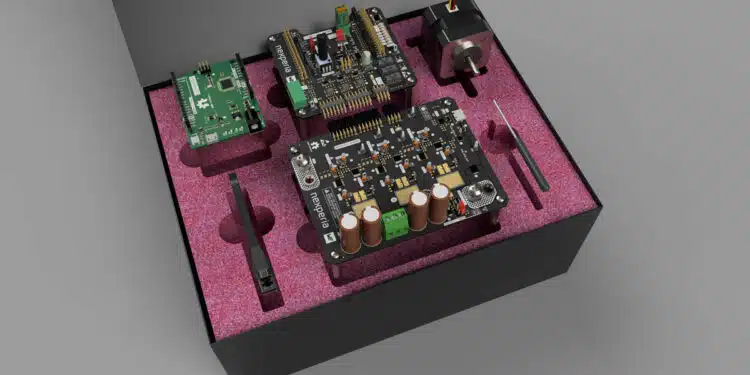Würth Elektronik and Nexperia present motor driver evaluation kit for faster development of efficient motor controllers.
Würth Elektronik and Nexperia have developed the NEVB-MTR1-KIT1 modular motor driver evaluation kit. The kit, created in collaboration, can be configured for use in under two minutes and is conveniently powered via USB-C.
Thanks to the open architecture, microcontrollers and components can be easily exchanged. Open-source firmware enables rapid adaptation and development of motor controllers under real-world conditions.
A particular highlight of the kit is the high-current connectors integrated by Würth Elektronik, which enable evaluations up to 1 kW at 48 V. The kit includes a 3-phase inverter board, a motor controller board, a microcontroller development board, pre-wired motor connections, and a BLDC (brushless DC) motor.
The demands on dynamics, fault tolerance, and energy efficiency in modern drive systems are rising steadily. The development of motor control systems has therefore become increasingly complex – a multidimensional technical task in which hardware and software must interact seamlessly.
Selecting the right switches (MOSFETs, IGBTs), gate drivers, and protection elements is crucial. Only an optimally matched driver-switch combination enables high efficiency and reliability. Inadequate selection, on the other hand, can lead to increased switching losses, critical thermal behavior, or unstable dynamics. The behavior of the components must be carefully validated under real-world conditions, taking into account factors such as parasitic elements, switching transients, and EMI.
This is where the modular kit makes things much easier for developers: it is designed so that different motors and control concepts can be operated – even using sensors.
Playground for engineers
“Our collaboration with Würth Elektronik brings together the strengths of both companies to support engineers in pushing the boundaries of what’s possible,” said Oleg Krapivner, Marketing Senior Director at Nexperia. “By combining passive components and power semiconductors on a single board, we’re providing a practical platform that helps accelerate innovation at the heart of designs. We’re offering more than just an evaluation tool – it’s a playground for engineers to experiment, iterate, and bring new ideas to life.”
“The NEVB-MTR1-KIT1 marks a paradigm shift in our evaluation boards, says Alexander Gerfer, CTO at the Würth Elektronik eiSos Group. “Rather than forcing engineers to adopt a fixed reference design, the board becomes a modular, developer-friendly platform that can be adapted to a wide range of motors, control algorithms, and test setups. This flexibility not only speeds up motor controller development but also enables faster iterations, testing, and optimization – exactly what modern development projects need.”































